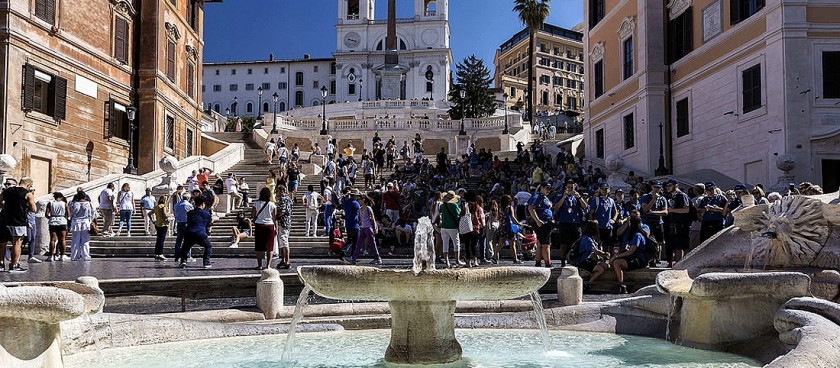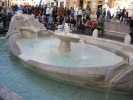- #IT11
- Piazza di Spagna, 00187 Roma, Italy
- 41.9059960, 12.4827720 Copy to clipboard Copy
-
#History , #Oddities
The monumental stairway of 174 steps (the slightly elevated drainage system is often mistaken for the first step) was built with French diplomat Étienne Gueffier’s bequeathed funds of 20,000 scudi, in 1723–1725 linking the Bourbon Spanish Embassy, and the Trinità dei Monti church that was under the patronage of the Bourbon kings of France, both located above — to the Holy See in Palazzo Monaldeschi located below. The stairway was designed by architects Francesco de Sanctis and Alessandro Specchi.
History
The piazza di Spagna in an 18th-century etching by Giovanni Battista Piranesi, seen from south. The street on the left is Via del Babuino, leading to Piazza del Popolo.
Following a competition in 1717 the steps were designed by the little-known Francesco de Sanctis, though Alessandro Specchi was long thought to have produced the winning entry. Generations of heated discussion over how the steep slope to the church on a shoulder of the Pincio should be urbanised preceded the final execution. Archival drawings from the 1580s show that Pope Gregory XIII was interested in constructing a stair to the recently completed façade of the French church. Gaspar van Wittel's view of the wooded slope in 1683, before the Scalinata was built, is conserved in the Galleria Nazionale, Rome. The Roman-educated Cardinal Mazarin took a personal interest in the project that had been stipulated in Gueffier's will and entrusted it to his agent in Rome, whose plan included an equestrian monument of Louis XIV, an ambitious intrusion that created a furore in papal Rome. Mazarin died in 1661, the pope in 1667, and Gueffier's will was successfully contested by a nephew who claimed half; so the project lay dormant until Pope Clement XI Albani renewed interest in it. The Bourbon fleur-de-lys and Innocent XIII's eagle and crown are carefully balanced in the sculptural details. The solution is a gigantic inflation of some conventions of terraced garden stairs. The Spanish Steps, which Joseph de Lalande and Charles de Brosses noted were already in poor condition, have been restored several times, most recently in 1995. A new renovation commenced on October 8, 2015 and the steps reopened on September 21, 2016.[
Piazza di Spagna
In the Piazza di Spagna at the base is the Early Baroque fountain called Fontana della Barcaccia ("Fountain of the longboat"), built in 1627–29 and often credited to Pietro Bernini, father of a more famous son, Gian Lorenzo Bernini, who is recently said to have collaborated on the decoration. The elder Bernini had been the pope's architect for the Acqua Vergine, since 1623. According to a legend, Pope Urban VIII had the fountain installed after he had been impressed by a boat brought here by a flood of the Tiber.
In the piazza, at the corner on the right as one begins to climb the steps, is the house where English poet John Keats lived and died in 1821; it is now a museum dedicated to his memory, full of memorabilia of the English Romantic generation. On the same right side stands the 15th-century former cardinal Lorenzo Cybo de Mari's palace, now Ferrari di Valbona, a building altered in 1936 to designs by Marcello Piacentini, the main city planner during Fascism, with modern terraces perfectly in harmony with the surrounding baroque context.
Uses
At the top, the stairway ramp up the Pincio which is the Pincian Hill. From the top of the steps the Villa Medici can be reached.
During Christmas time a 19th-century criba manger is displayed on the first landing of the staircase. During Springtime, just before the anniversary of the foundation of Rome, April 21, part of the steps are covered by pots of azaleas, up until early May. In modern times the Spanish Steps have included a small cut-flower market. The steps are not a place for eating lunch, being forbidden by Roman urban regulations, but they are usually crowded with people.


